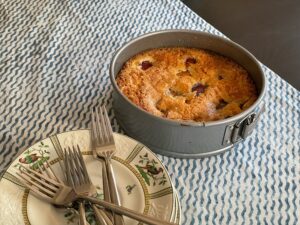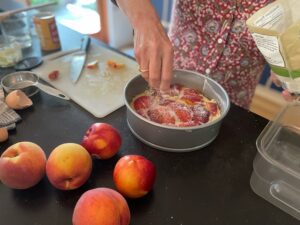I had to leave the Cape for a couple of weeks just as summer settled in. Aside from all the other inherent longings of homesickness — in this instance mostly along the x and y axes of the incomprehensible rushing of time and the preciousness of summer days here — I missed my weekly Wellfleet Farmers Market habit.
I missed the weekly browse-and-shop, and I missed seeing the bounteous haul piled on the kitchen counter afterward, the washing and sorting and finding places to store it all. I had gotten used to those rhythms, along with the subsequent poking around in the fridge contemplating what to make for dinner. I even missed the mounting anxiety of too-many-things-to-cook as the days went by and Wednesday morning came rolling back around.
On my first Wednesday back, in late July, my lode included yellow raspberries and nectarines from Victoria Pecoraro, along with a melon, cherry tomatoes, blueberries, and more of those harukei turnips with their greens. (I am obsessed with those turnips; for now, suffice it to say that a slow, easy braise with some soy sauce and butter and a touch of rice vinegar is your friend.) I also bought honey from Monopati and arugula and cilantro from Little G’s.
I bought the yellow raspberries with the intention of using them as an experiment in a bastard version of Marian Burros’s famous plum torte.
I got those raspberries home and started tasting them, at first one at a time and then by the spoonful, and finally I sat down and ate a bowl of them like the civilized person I am. I thought about my cake as I ate them, but they were so delicious it felt like a crime to do anything other than take them just as they came, unadorned. (I have to confess that later that morning I went back to the market to see if there were more. Dear reader, there were not.)
The next day, after another bowl for breakfast, I looked at the dwindling pile of raspberries with some concern. They stared back. The truth is, some fruits resist being made into a cake, especially when they are precious and probably the last of the harvest. On the other hand, I felt selfish not sharing them, and so I stared back, and then I grabbed some of the nectarines that sat winking on the other side of the counter. I thought of Solomon and decided I would split the baby. Not to belabor the metaphor, but my plan was not only to split the baby but to force it to play in the sandbox with a new friend.

That Marian Burros recipe has been my go-to for decades. Indeed, I would argue that for many it is the most dog-eared and batter-splattered recipe the New York Times has ever published, famously reprinted every year between 1983, when it was first published, and 1989, when the editors of the food section apparently said, “No more” and told readers to cut it out and laminate it. (Of course, that was before it was never more than a click away.)
I remember eating this cake well before 1983. It was an early favorite of my mother, who probably came across it in the 1960s in Burros’s and Lois Levine’s Elegant But Easy cookbook. I own a copy of the book and have almost tossed it hundreds of times, mostly because I am so unlikely to make things like devils on horseback, but I hang onto it because of nostalgia for the world the torte and I were born into.
The beauty of this particular cake — it does seem pretentious to call it a torte, and I think it is decidedly a cake — is that there is in fact nothing nostalgic about it: it is as modern as they come and as flexible as it is contemporary. The recipe is endlessly malleable, though also perfect in its original form.
During the beginning of health consciousness in the ’70s, my mother was drawn to versions with less sugar and probably less fat. I say meh to less fat, not only because it is central to flavor but because, like eggs, fat in a cake recipe forms a necessary structure. I have from time to time substituted a little olive oil for some of the butter, but on the whole I think olive oil cakes deserve their own recipes.

Similarly, I don’t vary the quantity of flour, though I do often include in the cup of flour things besides white flour, most often almond flour because it’s delicious with almost any fruit. I have experimented with mixing sugars, using some or all brown sugar. In this case I used some honey because I wanted to include something else from the farmers market. I could go on about forcing things to play together in the sandbox.
Perhaps most to the point, I have played endlessly with different kinds of fruit. I’ve made it with the original Italian plums often, and I highly recommend doing so when they come around in the fall. I’ve made it with apples and cinnamon (same!). I have yet to try it with cranberries for Thanksgiving, but I have long wanted to; perhaps this is the year. What I’m saying is, know that Marian will hold your creative vision: uncork the genie.
THANK YOU MARIAN BURROS TORTE
Makes one 8-inch or 9-inch cake
¾ to 1 cup sugar
4 oz. butter, softened
1 cup unbleached flour (Marian sifts, I do not)
1 tsp. baking powder
Pinch of salt (skip it if you are using salted butter)
2 eggs
Sugar and lemon juice for topping
About 3 cups fruit, enough to cover the cake: thick slices of nectarines or pear, whole raspberries, strawberries, blueberries, etc., singly or in combinations, or the plums, of course; enough to cover the cake
1. Heat oven to 350° F. Butter and flour an 8- or 9-inch springform (or ordinary) pan — the larger one makes a slightly flatter cake. Note that the buttering and flouring is not strictly necessary, and Marian’s recipe does not say to do it — a fearless and bold move on her part, and I admire it. But if you’re going to mess with the recipe, it’s good practice to use belt and suspenders.
2. Stir together the flour, baking powder, and salt. You could add about a teaspoon of cinnamon here or other spices. I’ve used cardamom to nice effect.
3. Cream the butter and sugar or sugars together. I’ve done this both by hand and in a standing mixer; either works. The cake will be a little fluffier with a stand mixer.
4. Mix eggs into the butter mixture and then stir in the flour mixture. Be careful not to overmix. Note that the batter for this cake is stiff; you may need to spread it to the edges of the pan with a spatula.
5. Place the fruit on the top. For larger fruits, cut them in half or quarters and place face down. If using berries, try to get them evenly distributed and poke them down slightly so the batter holds them. One of the best things about this cake is the way the batter bakes up around the fruit and embeds it as it does.
6. Sprinkle with a little lemon juice and extra sugar, if desired, and bake for about an hour, until a toothpick inserted in a cake-y part of the center comes out dry. Let the cake cool completely before serving.
